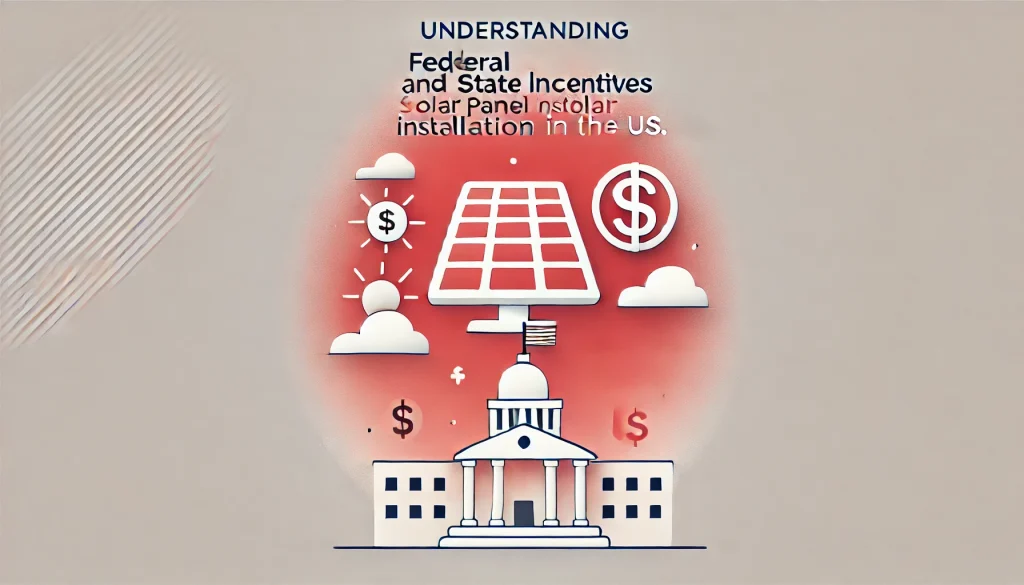US Solar Power: Maximize Federal and State Incentives 2025

US Solar Power: Solar energy is growing in popularity across the United States, as both individuals and businesses seek to reduce their carbon footprint and energy costs. With increasing environmental concerns and rising electricity prices, solar panels have become a smart, long-term investment. To encourage the adoption of renewable energy, the U.S. government—at both federal and state levels—offers a variety of financial incentives. Understanding these incentives is essential for anyone considering us solar power panel installation. This guide will walk you through the various federal and state incentives available in the U.S. for US Solar Power installation and help you make an informed decision.
Table of Contents
Why Solar Energy?
Before diving into the incentives, it’s essential to understand why US Solar Power energy is such an appealing option. US Solar Power energy offers numerous benefits, including:
- Cost Savings: Over time, solar panels can reduce or eliminate electricity bills, depending on your energy usage and local sunlight availability.
- Environmental Impact: Solar energy is a clean, renewable resource. By using solar power, you reduce greenhouse gas emissions and contribute to a cleaner environment.
- Energy Independence: By generating your electricity, you are less reliant on utility companies and less susceptible to price fluctuations in the energy market.
- Increased Property Value: Homes equipped with solar panels often see an increase in property value due to lower utility costs and long-term savings potential.
Now that we understand the benefits of solar energy, let’s explore the federal and state incentives available.
Federal Incentives for Solar Panel Installation
The federal government offers several key programs designed to make solar power more accessible and affordable for homeowners and businesses alike.
1. Federal Solar Investment Tax Credit (ITC)
One of the most significant federal incentives for US Solar Power panel installation is the Investment Tax Credit (ITC). The ITC allows homeowners and businesses to deduct a significant portion of their solar system costs from their federal taxes.
- 2024 and Beyond: Currently, the ITC offers a 30% tax credit for residential and commercial systems installed from 2022 through 2032. After 2032, the credit will decrease unless Congress extends it.
- Eligibility: Both residential and commercial solar installations qualify for the ITC. To be eligible, the system must be installed on your property, and you must own the system (i.e., leases or power purchase agreements do not qualify).
2. Accelerated Depreciation (MACRS)
Businesses that invest in US Solar Power energy can take advantage of the Modified Accelerated Cost Recovery System (MACRS), a federal tax incentive that allows them to recover the cost of their solar investment over a five-year period. In combination with the ITC, MACRS can significantly reduce the upfront cost of a solar installation for businesses.
- Bonus Depreciation: As of 2023, businesses can also benefit from 100% bonus depreciation, allowing them to deduct the full cost of their solar system in the first year.
3. Solar Renewable Energy Certificates (SRECs)
In some states, solar energy producers can earn additional income through Solar Renewable Energy Certificates (SRECs). Although this incentive varies by state, it is still considered a federal program as it often relies on compliance with state-level Renewable Portfolio Standards (RPS). Homeowners and businesses can sell their SRECs to utility companies to help them meet their renewable energy goals.
4. Rural Energy for America Program (REAP) Grants
The Rural Energy for America Program (REAP), administered by the U.S. Department of Agriculture (USDA), provides grants and loans to agricultural producers and rural small businesses for renewable energy systems, including solar. Grants can cover up to 25% of the project cost, and loans can finance up to 75%.
State Incentives for Solar Panel Installation
In addition to federal incentives, each state offers its own set of incentives, rebates, and credits for US Solar Power panel installation. These state-level incentives vary widely, so it’s essential to research the programs available in your area. Below, we’ll highlight some of the most popular state incentives.
1. State Tax Credits
Several states offer tax credits similar to the federal ITC, allowing homeowners and businesses to deduct a portion of their US Solar Power costs from their state income taxes. Some of the states with the most attractive tax credits for solar installation include:
- New York: The state offers a 25% tax credit on solar system costs, up to $5,000.
- South Carolina: Homeowners can claim a 25% tax credit on solar system costs, up to $35,000.
- Arizona: The state offers a 25% tax credit, up to $1,000, for residential solar installations.
2. Net Metering
Net metering is a crucial incentive available in many states, allowing homeowners and businesses to sell excess solar energy back to the grid. With net metering, your utility company credits your account for the surplus energy your solar panels produce, reducing your overall electricity bill.
- How It Works: If your US Solar Power system produces more electricity than you consume, the excess energy is sent back to the grid. In exchange, you receive a credit that can be applied to future energy use.
- State Variations: Net metering policies vary by state, with some states offering one-to-one credit for excess energy, while others provide reduced rates. States like California, New Jersey, and Massachusetts have some of the most favorable net metering policies.
3. Rebates and Cash Incentives
Many states, municipalities, and utility companies offer rebates or cash incentives to offset the upfront cost of solar installations. These rebates can vary from a few hundred to several thousand dollars, depending on the size and location of the solar system.
- Examples:
- California: The California Solar Initiative (CSI) offers cash rebates for homeowners and businesses that install solar panels.
- Massachusetts: The Massachusetts Clean Energy Center offers rebates for residential solar systems, with additional incentives for low-income households.
- New York: The NY-Sun Incentive Program provides rebates based on system size, with higher incentives for residential installations in specific regions.
4. Property and Sales Tax Exemptions
In some states, US Solar Power panels are exempt from property and sales taxes, helping to reduce the overall cost of installation.
- Property Tax Exemption: Many states, including Florida, Texas, and Illinois, offer property tax exemptions for solar installations. This means that even though solar panels increase your home’s value, you won’t pay additional property taxes.
- Sales Tax Exemption: Some states, like New York, New Jersey, and Massachusetts, exempt solar systems from state sales tax, reducing the upfront cost of equipment and installation.
Local and Utility-Specific Incentives
In addition to federal and state incentives, many local governments and utility companies offer their own solar incentives. These incentives can include rebates, performance-based incentives, and low-interest loan programs.
- Austin, Texas: The Austin Energy rebate program provides incentives based on the size of the solar system, with rebates up to $2,500 for residential installations.
- Salt Lake City, Utah: The Rocky Mountain Power Solar Incentive Program offers rebates for both residential and commercial solar systems.
To find local incentives in your area, consider using the Database of State Incentives for Renewables & Efficiency (DSIRE), which provides a comprehensive list of all federal, state, and local incentives available for solar panel installations.
How to Maximize Your Solar Incentives
When planning a solar panel installation, it’s essential to maximize the financial incentives available to you. Here are some steps to ensure you get the most out of these programs:
- Research Local Programs: In addition to federal incentives, look into state, municipal, and utility-specific programs. Some of the best incentives may come from your local utility company or government.
- Hire a Reputable Solar Installer: Work with a certified and experienced solar installer who can help you navigate the incentive landscape. A professional installer will know which incentives you’re eligible for and how to apply for them.
- Claim All Eligible Tax Credits and Rebates: Be sure to claim both federal and state tax credits. Some rebates and incentives require applications before installation, so plan accordingly.
- Consider Financing Options: Many solar installers offer financing options, including solar loans, power purchase agreements (PPAs), and solar leases. If you’re considering financing, make sure to factor in the availability of tax credits and rebates to reduce your total cost.
- Monitor Policy Changes: Solar incentives can change over time. Stay updated on any changes to federal or state policies that may affect your eligibility for incentives.
Conclusion
Understanding the full range of federal and state incentives available for solar panel installation can significantly reduce the cost of going solar. From the federal Investment Tax Credit (ITC) to state-specific tax credits, rebates, and net metering programs, there are numerous opportunities to save money on your solar investment. By leveraging these incentives, you can maximize your savings while reducing your environmental impact.
If you’re considering a solar panel installation, be sure to research the incentives available in your area and work with a trusted solar installer to guide you through the process.
Contact Information:
For more details or inquiries about solar panel installation and incentives, feel free to contact:
Solar Power Solutions
Website: www.solarpowersolutions.com
Location: 123 Green Energy Road, Los Angeles, CA 90210
Phone: (123) 456-7890
Email: [email protected]


